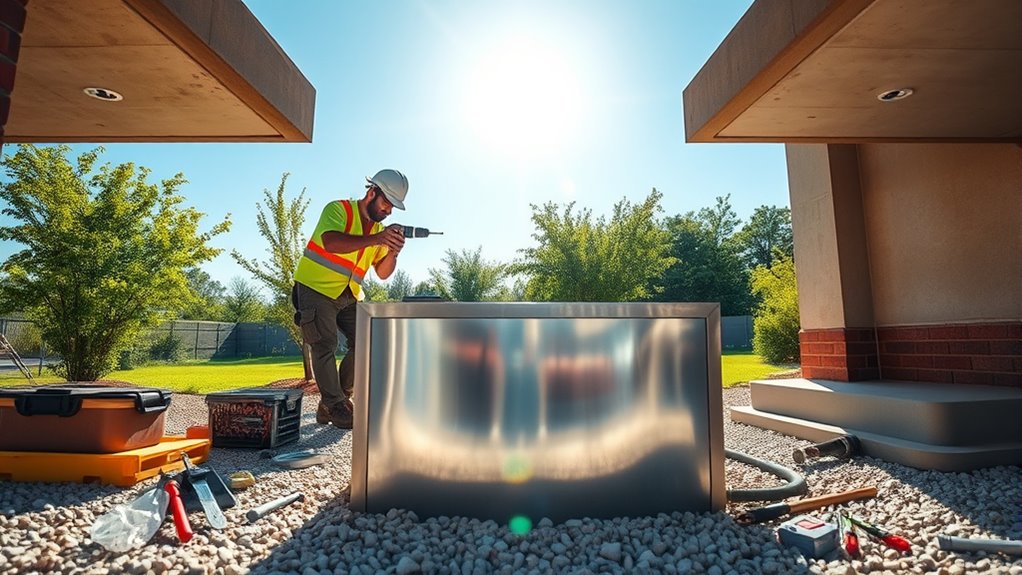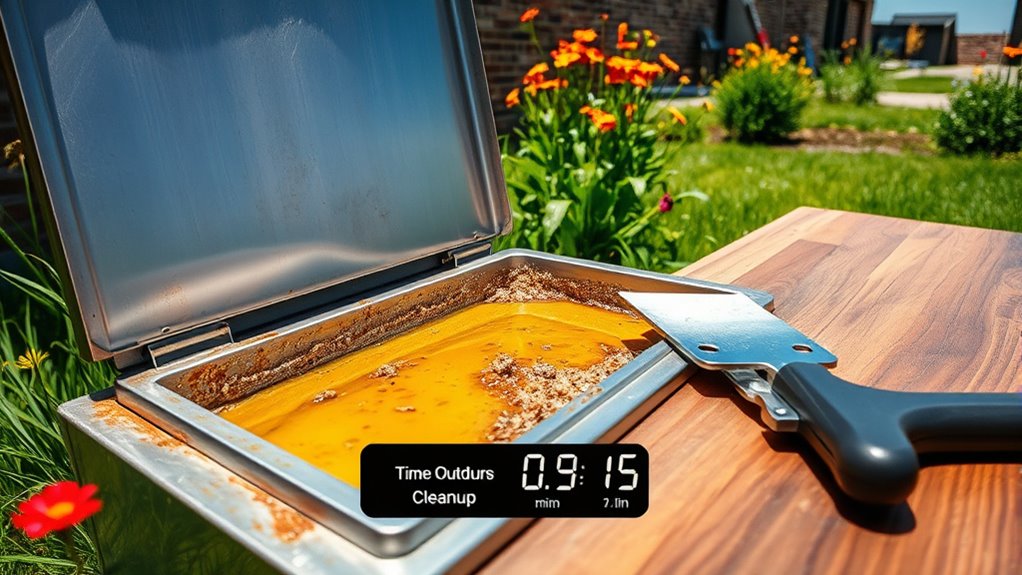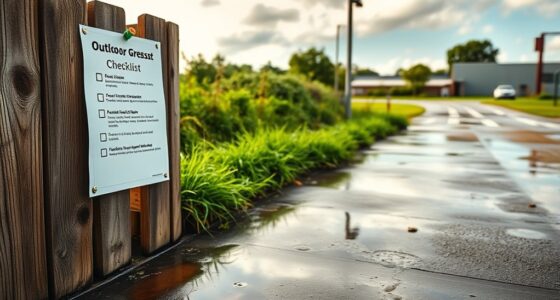To quickly manage outdoor grease in 15 minutes, start by cleaning visible grease spots with a sturdy brush or scraper, then rinse surfaces with a high-pressure hose, directing runoff into your grease trap or designated area. Apply eco-friendly degreasers to break down stubborn grease and wipe away residue efficiently. Regularly scheduled, brief cleanings prevent buildup and reduce odors, saving you time and avoiding costly repairs. Keep going to discover even more effective, easy tips for outdoor grease control.
Key Takeaways
- Install a properly sized outdoor grease trap to capture grease before it enters drainage systems.
- Use a high-pressure hose and stiff brush to quickly clean grease residues from surfaces.
- Apply eco-friendly degreasers to break down grease buildup efficiently in short sessions.
- Allow hot grease to cool before disposing of it in designated containers to prevent clogs.
- Schedule regular 15-minute cleaning routines to maintain outdoor areas and prevent grease accumulation.
Quick and Easy Outdoor Grease Management Tips

Managing outdoor grease buildup doesn’t have to be a lengthy or complicated task. With a few quick steps, you can keep your outdoor areas clean and prevent costly problems down the line. One of the first things you should consider is proper grease trap installation. Installing a well-designed grease trap helps catch fats, oils, and grease before they enter your drainage system, reducing the risk of clogs and unpleasant odors. If you haven’t set one up yet, it’s worth dedicating a short time to choosing the right size and location for your needs. A correctly installed grease trap is a long-term solution that makes ongoing outdoor cleaning techniques much easier and more effective.
Once your grease trap is in place, you can focus on simple outdoor cleaning techniques to keep your environment tidy. Start by regularly removing any visible grease or oily residues around your cooking or washing areas. Use a sturdy brush or scraper to loosen stubborn grease deposits on surfaces like concrete or pavement. Follow up with a high-pressure hose if you have one—this is a quick way to wash away grease and debris without a lot of effort. Just be sure to direct the runoff into your grease trap or designated drainage area to prevent grease from spreading into your yard or storm drains.
For more targeted grease removal, consider applying a degreasing agent or a bio-based cleaner designed for outdoor use. These solutions break down grease quickly and are environmentally friendly. Spray or scrub the affected areas, then rinse thoroughly. Doing this regularly prevents grease from building up over time, which can lead to more significant problems later. Remember, consistency is key—spending just 15 minutes a few times a week on these outdoor cleaning techniques can keep grease under control and your outdoor space looking great.
Another tip is to manage your grease disposal properly. Never pour hot grease down the drain or onto the ground. Instead, pour cooled grease into a container for proper disposal or recycling. This prevents future clogs and keeps your outdoor environment safe and clean. Using portable grease traps can be an effective way to simplify this process. If you notice ongoing grease accumulation, revisit your grease trap installation to ensure it’s functioning correctly, and adjust your cleaning frequency as needed.
In just minutes a few times a week, you can effectively manage outdoor grease buildup without it becoming a major chore. The key is setting a routine that includes proper installation, regular cleaning, and responsible disposal. By incorporating these outdoor cleaning techniques into your maintenance, you’ll save time, reduce odors, and protect your property from costly drainage issues—all in just 15 minutes at a time.
Frequently Asked Questions
Can Outdoor Grease Management Be Effective in Winter Conditions?
Yes, outdoor grease management can be effective in winter conditions if you address winter challenges properly. You should use insulated or heated containers to prevent freezing and choose durable, weather-resistant materials for outdoor setups. Regular maintenance and timely inspections help maintain outdoor efficiency despite cold temperatures. By adapting your grease management practices to winter challenges, you ensure consistent performance and minimize environmental risks, keeping your operations smooth year-round.
Are DIY Grease Trap Solutions Environmentally Friendly?
DIY grease trap solutions can be environmentally friendly if you choose biodegradable materials and chemical alternatives. You might think they’re less effective, but with proper design, they can trap grease without harming the environment. Using biodegradable products reduces chemical runoff, protecting nearby soil and water sources. Always research and select eco-friendly options to guarantee your DIY setup promotes sustainability while effectively managing grease outdoors.
How Often Should Outdoor Grease Management Systems Be Inspected?
You should inspect your outdoor grease management system at least once every three to six months, depending on usage. Regular inspections help identify any buildup or leaks early, ensuring peak performance. Stick to a consistent maintenance schedule, especially after busy periods, to prevent blockages and odors. By staying proactive, you’ll extend the system’s lifespan and keep your outdoor area clean and compliant with local regulations.
What Are the Costs Associated With Professional Outdoor Grease Management?
Think of professional outdoor grease management costs as planting seeds for a smooth-running operation. You’ll face expenses for initial setup, routine inspections, and potential repairs, all part of your cost analysis. Budget considerations vary based on system size and complexity, but investing upfront can save you money and headaches later. Staying proactive guarantees your outdoor grease management remains efficient, preventing costly backups and environmental issues down the road.
Can Outdoor Grease Management Methods Prevent Pests Effectively?
Yes, outdoor grease management methods can effectively prevent pests. You can use organic composting to safely break down grease, reducing attraction for pests, and install wildlife deterrents around your outdoor area. These strategies make your environment less appealing to rodents and insects, keeping pests at bay. Regular maintenance and combining organic composting with wildlife deterrents guarantee your outdoor space stays clean and pest-free efficiently.
Conclusion
Now, in just 15 minutes, you’ve mastered outdoor grease management—simple, quick, effective. It’s easy to overlook the importance of proper grease care until a mess or clog shows up. But by acting now, you prevent costly repairs and environmental harm. Think of it like a small investment that saves you big headaches later. Fast, straightforward, and essential—these quick wins turn outdoor grease management from a chore into a confident, effortless routine.









